Precursor of advanced glycation end products mediates ER-stress-induced caspase-3 activation of human dermal fibroblasts through NAD(P)H oxidase 4
- PMID: 20559423
- PMCID: PMC2885413
- DOI: 10.1371/journal.pone.0011093
Precursor of advanced glycation end products mediates ER-stress-induced caspase-3 activation of human dermal fibroblasts through NAD(P)H oxidase 4
Abstract
Background: The precursor for advanced glycation end products, 3-deoxyglucosone (3DG) is highly upregulated in skin explants of diabetic cutaneous wounds, and has been shown to negatively impact dermal fibroblasts, which are crucial in wound remodeling. 3DG induces apoptosis however; the mechanisms involved in the apoptotic action of 3DG in the pathogenesis of diabetic chronic wounds are poorly understood. Therefore, we sought to delineate novel mechanisms involved with the 3DG-collagen induced apoptosis.
Methodology/principal findings: Using human dermal fibroblasts, we demonstrated that 3DG-modified collagen induces oxidative stress and caspase-3 activation. Oxidative stress was found to be dependent on the upregulation of NAD(P)H oxidase 4 (Nox4), a reactive oxygen species (ROS) Nox homologue, triggering endoplasmic reticulum (ER) stress, as assessed by the ER stress-induced apoptosis marker Growth Arrest and DNA Damage-inducible gene 153 (GADD153). We demonstrated that 3DG-collagen activated GADD153 via phosphorylation of p38 mitogen activated protein kinase (MAPK), and this was dependent on upstream ROS. Inhibition of ROS and/or p38 MAPK abrogated 3DG-collagen induced caspase-3 activation. Our investigations also demonstrated that 3DG-collagen-induced caspase-3 activation did not signal through the canonical receptor for advanced glycation end products (RAGE) but through integrin alpha1beta1. To further verify the role of integrins, neutralization of integrins alpha1beta1 prevented 3DG-collagen-induced upregulation of ROS, GADD153, and caspase-3 activation; suggesting that 3DG-collagen signaling to the fibroblast is dependent on integrins alpha1beta1.
Conclusions/significance: Taken together, these findings demonstrate for the first time that a RAGE independent mechanism is involved in 3DG-collagen-induced apoptosis. Moreover, the ER stress pathway through activation of Nox4 by integrins alpha1beta1 plays a key role in 3DG-collagen-induced caspase-3 activation, which may play an important role in the pathogenesis of diabetic wounds.
Conflict of interest statement
Figures

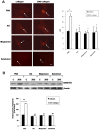

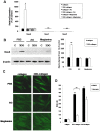

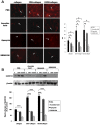

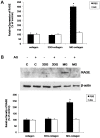
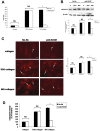
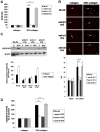
Similar articles
-
Modification of collagen by 3-deoxyglucosone alters wound healing through differential regulation of p38 MAP kinase.PLoS One. 2011 May 6;6(5):e18676. doi: 10.1371/journal.pone.0018676. PLoS One. 2011. PMID: 21573155 Free PMC article.
-
Advanced glycation end products induce apoptosis in fibroblasts through activation of ROS, MAP kinases, and the FOXO1 transcription factor.Am J Physiol Cell Physiol. 2007 Feb;292(2):C850-6. doi: 10.1152/ajpcell.00356.2006. Epub 2006 Sep 27. Am J Physiol Cell Physiol. 2007. PMID: 17005604
-
Activation of NADPH oxidase 4 in the endoplasmic reticulum promotes cardiomyocyte autophagy and survival during energy stress through the protein kinase RNA-activated-like endoplasmic reticulum kinase/eukaryotic initiation factor 2α/activating transcription factor 4 pathway.Circ Res. 2013 Nov 8;113(11):1253-64. doi: 10.1161/CIRCRESAHA.113.301787. Epub 2013 Sep 30. Circ Res. 2013. PMID: 24081881 Free PMC article.
-
The Role of AGE/RAGE Signaling in Diabetes-Mediated Vascular Calcification.J Diabetes Res. 2016;2016:6809703. doi: 10.1155/2016/6809703. Epub 2016 Jul 28. J Diabetes Res. 2016. PMID: 27547766 Free PMC article. Review.
-
Nox as a target for diabetic complications.Clin Sci (Lond). 2013 Oct;125(8):361-82. doi: 10.1042/CS20130065. Clin Sci (Lond). 2013. PMID: 23767990 Review.
Cited by
-
The cGAS-STING pathway: a therapeutic target in diabetes and its complications.Burns Trauma. 2024 Feb 2;12:tkad050. doi: 10.1093/burnst/tkad050. eCollection 2024. Burns Trauma. 2024. PMID: 38312740 Free PMC article. Review.
-
Ischemic brain injury in diabetes and endoplasmic reticulum stress.Neurochem Int. 2022 Jan;152:105219. doi: 10.1016/j.neuint.2021.105219. Epub 2021 Nov 1. Neurochem Int. 2022. PMID: 34736936 Free PMC article. Review.
-
Glycation by glyoxal leads to profound changes in the behavior of dermal fibroblasts.BMJ Open Diabetes Res Care. 2021 Apr;9(1):e002091. doi: 10.1136/bmjdrc-2020-002091. BMJ Open Diabetes Res Care. 2021. PMID: 33903117 Free PMC article.
-
Research Progress on Gestational Diabetes Mellitus and Endothelial Dysfunction Markers.Diabetes Metab Syndr Obes. 2021 Mar 3;14:983-990. doi: 10.2147/DMSO.S295737. eCollection 2021. Diabetes Metab Syndr Obes. 2021. PMID: 33688231 Free PMC article. Review.
-
Beta carotene protects H9c2 cardiomyocytes from advanced glycation end product-induced endoplasmic reticulum stress, apoptosis, and autophagy via the PI3K/Akt/mTOR signaling pathway.Ann Transl Med. 2020 May;8(10):647. doi: 10.21037/atm-20-3768. Ann Transl Med. 2020. PMID: 32566584 Free PMC article.
References
-
- Huijberts MS, Schaper NC, Schalkwijk CG. Advanced glycation end products and diabetic foot disease. Diabetes Metab Res Rev. 2008;24(Suppl 1):S19–24. - PubMed
-
- Ramsey SD, Newton K, Blough D, McCulloch DK, Sandhu N, et al. Incidence, outcomes, and cost of foot ulcers in patients with diabetes. Diabetes Care. 1999;22:382–387. - PubMed
-
- Singh N, Armstrong DG, Lipsky BA. Preventing foot ulcers in patients with diabetes. JAMA. 2005;293:217–228. - PubMed
-
- Aoki Y, Yazaki K, Shirotori K, Yanagisawa Y, Oguchi H, et al. Stiffening of connective tissue in elderly diabetic patients: relevance to diabetic nephropathy and oxidative stress. Diabetologia. 1993;36:79–83. - PubMed
-
- Caron-Mazet J, Roth B, Guillaume JC. [Prevalence and management of chronic wounds in 14 geriatric institutions of the Haut-Rhin]. Ann Dermatol Venereol. 2007;134:645–651. - PubMed
Publication types
MeSH terms
Substances
LinkOut - more resources
Full Text Sources
Other Literature Sources
Research Materials

